|
Location:
10km North east of Cairo,
Egypt. |
Grid Reference:
30� 06' 00" N. 31� 19'
00" E |
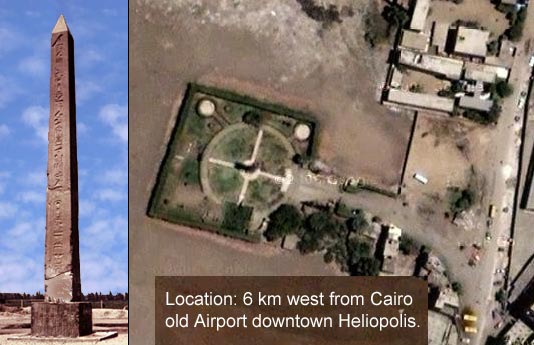
 Heliopolis:
('Sun City', 'Anu', 'Lunu', 'On').
Heliopolis:
('Sun City', 'Anu', 'Lunu', 'On').
Shows evidence of occupation since
pre-dynastic times
(1).
Heliopolis was once one of the
largest cities in ancient Egypt, It was the capital of the cult of Amon-Ra,
second only in size by Thebes (Karnak). The chief deity of Heliopolis was the god Atum, who was worshipped in
the primary temple, which was known by the names Per-Aat (pr-at;
"Great House") and Per-Atum (pr-ỉtmw; "Temple [lit.
"House"] of Atum")
Several of the obelisks in Rome originated from
Heliopolis, as did both the Cleopatra's needles in London, and New York.
(Click here for map of location)
The ancient city of
Heliopolis, the city of 'On' in the Bible, was the chief town of the
13th nome of Egypt (These nomes were ancient
administrative borders with roots tracing right back to the
unification by Menes (c. 3,100 BC). In Egyptian mythology
its name was lunu, meaning 'pillar' and it was thought to be
the location of the 'mound of creation' from which the world arose
from the waters.
 The position of the great temple
is marked by a single obelisk, being
one of a pair set up by Senusret I, the second king of the Twelfth
Dynasty) and a few granite blocks bearing the name of Ramesses II.
Now buried almost directly under the sprawling city of Cairo, the archaeological
context of this city remains are going to remain difficult to interpret. The position of the great temple
is marked by a single obelisk, being
one of a pair set up by Senusret I, the second king of the Twelfth
Dynasty) and a few granite blocks bearing the name of Ramesses II.
Now buried almost directly under the sprawling city of Cairo, the archaeological
context of this city remains are going to remain difficult to interpret.
We know
that there was a religious centre dedicated to Djoser Netjerikhet of
the 3rd Dynasty. Several fragments of very fine limestone relief were
found in the temple area at Heliopolis excavated in 1903 by Schiaperelli. Now exhibited in the Turin Egyptian museum, the
fragments show lines of text naming Netjerikhet, and stress the
importance of the solar cult at that time.
(Click on image right for
full-size view)
|
Pyramid Alignment Towards Heliopolis: |
It can be seen that many of the pyramids of
the 4th and 5th dynasty were positioned so that their
corners aligned towards Heliopolis.
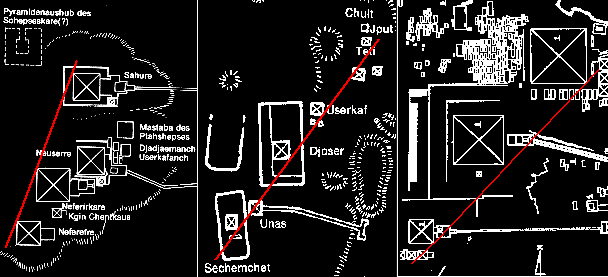 Pyramid sight lines at Abusir,
Saqqara and
Giza
Pyramid sight lines at Abusir,
Saqqara and
Giza
It was Hans Goedicke who made the first
suggestions over this theory, but they were not published first in a scientific journal, but
in a newspaper in 1983. And what does the theory say? Well, Goedicke noticed
that there seems to be a common constructional element at several
necropolises: one corner of each structure is often on a straight line with
the same corner of other structures in the necropolis. These alignments are
found at Giza (south-east corners of Khufu, Kaphere and Menkaure), Abusir
(north-west-corner of the pyramids of Sahure, Neferirkare und Neferefre),
Saqquara (south-east-corners of Sekhemkhet, Djoser, Userkaf und Teti) - and
even between necropolises as Goedicke thinks that the east face of Userkaf's
Pyramid is aligned with the same face of Khufu's Pyramid several kilometres
to the north.
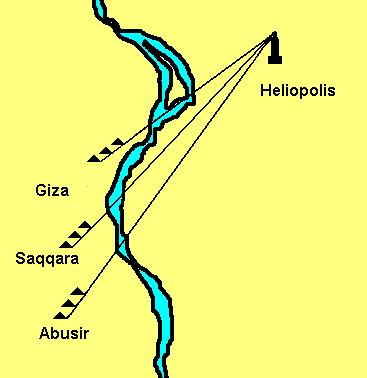
Goedicke later concluded that these sight lines were aimed at the
solar temple at Heliopolis.
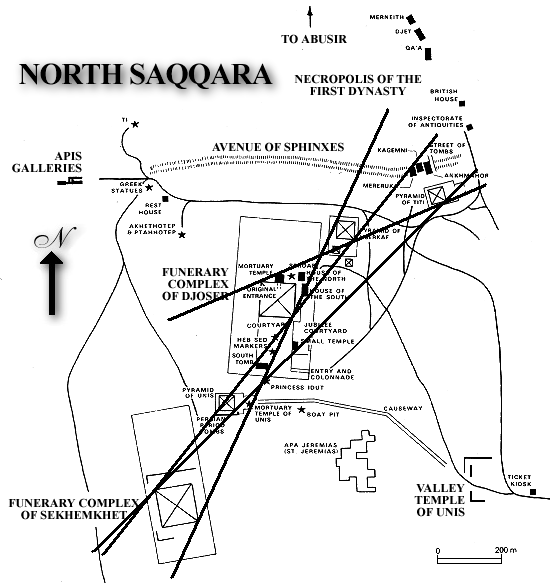
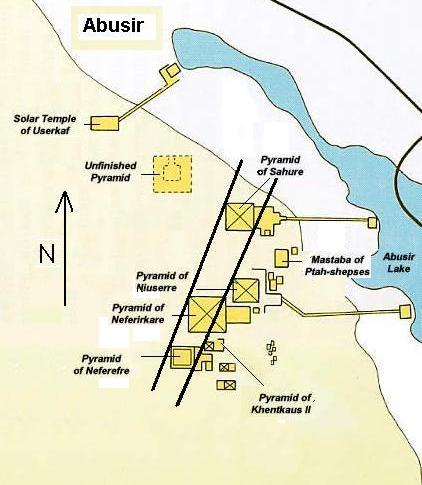 It appears that there are more alignments
to be found at each site ...
It appears that there are more alignments
to be found at each site ...
Verner notes also that at
Abusir, the 'Unfinished pyramid' was finally determined to have belonged
to Neferefre, a suggestion which finds support in its placement at the
southwest of the Abusir complex, suggesting a chronological placement. He
says:
'As a precise geodetic measurement has confirmed, its
northwest corner is on a line that already connected Sahure's and
Neferirkare's pyramids and represented the basic axis of the pyramid
necropolis at Abusir'
(3).
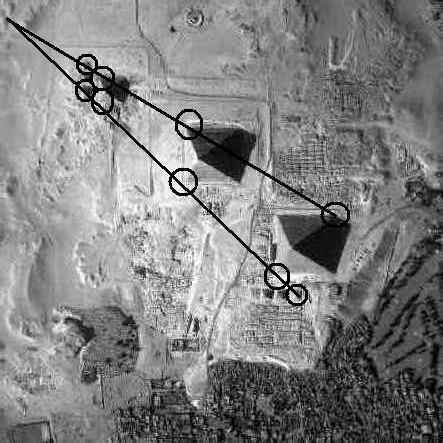
As we can see,
Giza has two sets of corner-alignments, not one.
(More
about the Alignment of Pyramid Corners)
|
The Chronology of Heliopolis: |
The exact origins of Heliopolis are sadly lost to us at present, but the
fact that it is included in the creation myth gives it an
obvious importance that extends back to pre-dynastic times.
Excavations in
the area revealed that the depths beneath the city of Heliopolis go
back to prehistoric times. An old cemetery dating back to the second
Naqada period was uncovered there.
(3)
In the Old-Kingdom Heliopolis was a centre of
astronomy, as reflected in the title of the high priest who was called
the 'chief of observers'.
By the time of the
Middle-Kingdom, it had become the centre of the cult
of Amun-Ra (following the association pf Atum and Ra/Re). Donation lists from the time of Ramases II indicate that the temple at Heliopolis were second only to
that of Amun at Thebes.
Herodotus stated that the priests of Heliopolis
were the best informed in matters of history of all the Egyptians.
Heliopolis flourished as a seat of learning during the Greek period;
the schools of philosophy and astronomy are claimed to have been
frequented by Orpheus, Homer, Pythagoras, Plato, Solon, and other
Greek philosophers
(1)
The city was largely destroyed in the Persian
invasion of 525 BC.
The significance of the city was lost following the
founding of Alexandra in 332 BC. The old monuments were plundered and
the remains were used as a quarry for building much of medieval Cairo,
and other civil projects since.
When Strabo visited the city (1st cent BC), he
found it almost deserted.
Diodorus Siculus
wrote in 60BC that Heliopolis was built by Actis, one of the sons of
Helios and Rhode.
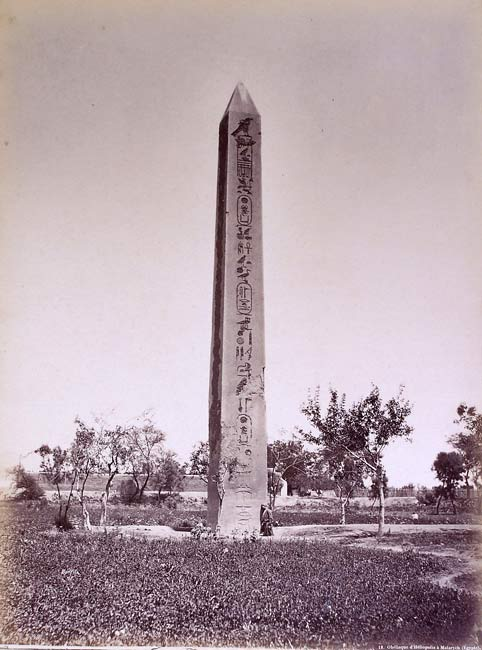
Though only
fragments of Heliopolis� city walls remain, they were easily
discernable at the time of the French Expedition in 1798,
portions of these walls stood ten to twelve meters high.
Today, all that remains of this once great city is the single (20.4m high,
121 ton), obelisk, originally one of a pair erected at the entrance of a
huge temple to mark the 12th dynasty king Senusret I's 30th anniversary
at around 1940 BC. (and a few granite blocks bearing the name of
Ramesses II).
(More
about Egyptian obelisks)
According to Heliopean tradition, the first act
of creation occurred when the sun god Atum, "Lord of Heliopolis",
rose out of the chaos of Nun from a lotus flower and stood on a
raised mound he created, the ben-ben. This first act of
creation brought light into the world. At the site of his
emergence, the temple of Heliopolis was built.
Heliopolis is where the cosmic creation of Egyptian
myth began. Ancient Egyptian mythology states that in the
beginning of time everything began with Nu. Nu is the
description of what the planet was before land appeared. Nu
was a vast area of swirling watery chaos and as the floods
receded the land appeared. The first god to appear out of
this watery mess was Atum.
Atum emerged from Nu as the sun god at the beginning of
time and is the creator of the world. Since Atum was all alone
he chose to mate with his shadow. Atum gave birth to two children by
spitting out his son (Shu) and vomiting up is daughter (Tefnut).
(Or by masturbating them, depending on version), Shu represented the air and the principles of life and Tefnut
represented rain and principles of order. The three remained
in the watery chaos of Nu and after some time Atum was
separated from his children. When they were finally reunited,
Atum wept with tears of joy. When his tears hit the ground men
grew and he then began to create the world. Shu and Tefnut
later gave birth to Geb, the god of the earth in which the
throne of the Pharaoh would be decided. Nut was also born
from Tefnut and Shu as the Goddess of the sky, the separator
between earth and Nu. Geb and Nut then gave birth to Osiris,
Isis, Seth, and Nephthys.
Atum is
known also as Khepri, the great scarab beetle, Ra-Harakhte,
the winged-solar disk, Ra, the midday sun, Aten, the
solar-disk, or Horus on the Horizon. By whatever name you call
him Atum, is the one and only creator in the universe. The sun
god Atum travels along Nut during the day and then is
swallowed by Nut at night. At dawn it is seen as Nut giving
birth to Atum as the sky opens up to the light.
References to Heliopolis in the Bible.
Genesis (41:45) - And Pharaoh called
Joseph's name Zaphnathpaaneah; and he gave him to wife Asenath
the daughter of Potipherah priest of On. And Joseph went out
over all the land of Egypt. (King James Bible)
Ezekiel (30:17)
- "The young men of On and of Pi-beseth Will fall by the
sword, And the women will go into captivity.
On was the name for Heliopolis in the
Bible.
Jeremiah 43:13 - He shall break also
the images of Bethshemesh, that is in the land of Egypt; and
the houses of the gods of the Egyptians shall he burn with
fire. (King James Bible)
Beth-shemesh is, "the house of the sun,"
in Hebrew; called by the Greeks "Heliopolis".
(Other Egyptian
Sites)
|




 It appears that there are more alignments
to be found at each site ...
It appears that there are more alignments
to be found at each site ...
